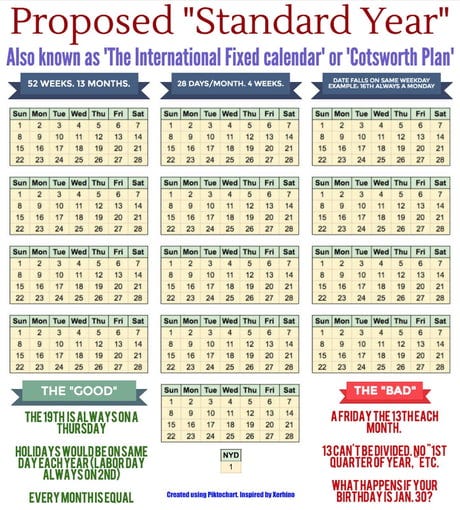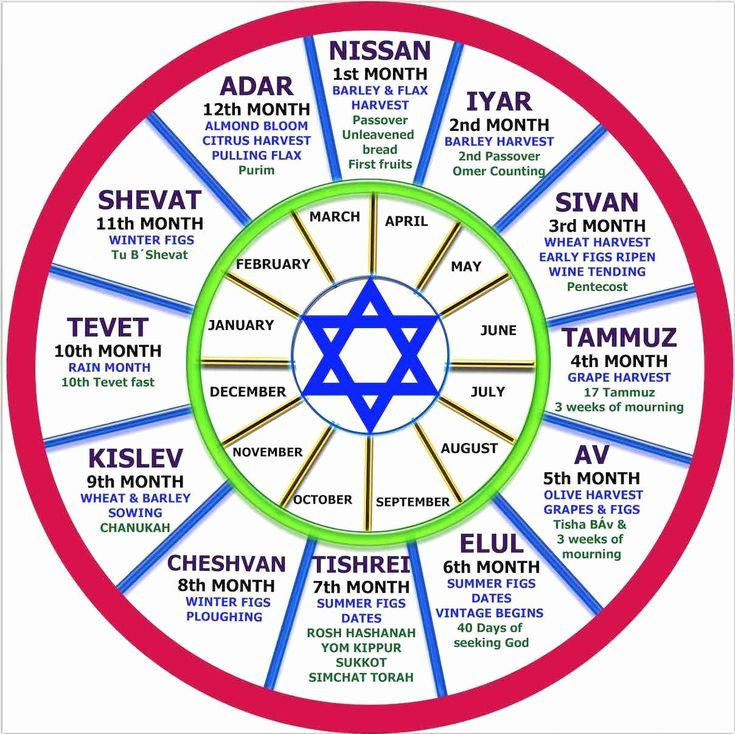Welcome back readers and Happy Leap Day! That calendar oddity that occurs every four years, creating a day that is sort of February, not quite March, and should definitely not be a workday.
Wouldn’t life be so much easier with 13 equal-sized months, where each month is exactly 28 days starting on Sunday and ending on Saturday? This 364-day standard year would also feature a bonus world holiday called “New Year Day” on the 365th day that would not belong to any month.
Why do we have such a wacky calendar?
We follow the Julian calendar, named after Julius Caesar who initiated its development in 45 BCE as a reform to the Roman calendar, a lunar calendar that featured 10 months with an additional leap month inserted every few years to align with the seasons.
The Julian calendar was designed to better align the calendar year with the astronomical year—the time it takes for the Earth to complete one orbit around the Sun. The months of January and February were added to the calendar and the original fifth and sixth months were renamed July and August in honor of Julius Caesar and his successor Augustus. These summer months were both given 31 days to reflect their importance, having been named after Roman leaders.
LEAPING LEAPERS
On average, the moon revolves around the Earth in about 29½ days. The astronomical year is not a neat 365 days but is roughly 365¼ days or about 12.4 lunar months. Therefore, if a calendar year consists of only 365 days, there is a drift between the calendar and the seasons over time. Leading to the calendar slipping by one day every four years causing a significant misalignment over time. The Julian calendar addressed this by introducing a leap year every four years.
Why did February get a 29th day?
The choice of February 29 as the leap day is somewhat arbitrary but February was the last month of the Roman calendar year, so it made sense to adjust the calendar at the end of the year.
However, the Julian calendar is not perfect, the actual solar year is closer to 365.2425 days. This slight difference meant that the Julian calendar introduced an error of about 1 day every 128 years. This discrepancy slowly shifted important dates like the vernal equinox over centuries, which was problematic, notably for determining the date of Easter.
Behold the Gregorian calendar reform in 1582, initiated by Pope Gregory XIII, that sought to correct this drift. The reform established that a year that is exactly divisible by 100 would not be a leap year unless it is also divisible by 400. Thus, years like 1600 and 2000 are leap years, but 1700, 1800, and 1900 are not. This refinement resulted in a closer approximation to the solar year and reduced the error dramatically to only about 1 day every 3,030 years.
ENTER THE DRAGON
The Chinese calendar is a lunisolar calendar that is based on the moon's phases and the Earth's orbit around the sun. It is also known as the Xia calendar, Yin calendar, or old Chinese calendar. The Chinese calendar is used for religious purposes, festivals, and agriculture. Each year in the calendar has a zodiac sign
The Chinese calendar has 12 months, with 29 or 30 days in each month. A year has 354 days, or about 12 lunar cycles because each month alternates between 29 and 30 days. The first day of the lunar month is when the moon, earth, and sun align.
The calendar like the original Roman calendar features leap months to stay calibrated. As a result, the Chinese New Year, or Spring Festival, the most celebrated juncture in this calendar, rarely occurs on the same date. Instead, the holiday is celebrated on the new moon between January 21 and February 20., ushering in a fortnight of festivities rooted in centuries-old traditions and rituals aimed at attracting good fortune, health, and prosperity.
It turns out the Jews and the Chinese have more in common than their love of Mahjong.
The Jewish calendar is also lunisolar and is based on three astronomical phenomena: the rotation of the Earth about its axis (a day); the revolution of the moon about the Earth (a month); and the revolution of the Earth about the sun (a year).
This system leads to a typical lunar year of 354 days To reconcile this discrepancy the calendar adds a leap month seven times in a 19-year cycle, known as the Metonic cycle. This periodic addition of a second Adar, the leap month, helps realign the lunar months with the solar year, ensuring, for instance, that Passover always occurs in the spring as commanded in the Torah.
ONE (LEAP) DAY AGO
A day occurring once every four years creates a nice time capsule.
What was life like last leap day?
Wall Street suffered its worst week since 2008 - If only you bought into NVIDIA which at the time was trading around $67.50 a share.
Trump accused Democrats of Outbreak Hoax - Another of the do-nothing Democrats ever-constant witch hunts that have only led to four indictments and 90 criminal charges against the former President.
An artist named Biden - Hunter Biden attempted to launch his career as an auteur. If you are reading this at work. Do not. I repeat DO NOT google Hunter Biden videos.
TURNING HOBBIES INTO REALITY
First principles thinking is a foundational problem-solving strategy that involves breaking down complex problems into their most basic, fundamental elements. It's about stripping away the layers of pre-existing assumptions and beliefs to get to the root truths underlying a concept or problem. This method encourages a deep understanding of the situation at hand, free from the influence of tradition, convention, or what has been accepted historically.
A polymath is a person with a wide-ranging knowledge base and expertise across multiple disciplines. This character is driven by an insatiable curiosity and an innate ability to understand and integrate concepts from diverse fields, leading to innovative thinking and problem-solving skills. Unlike specialists who focus deeply on a singular area, polymaths thrive on the breadth of their interests, often excelling in both the arts and sciences, blending technical skill with creative insight.
The very nature of being a polymath means that conventional paths might feel limiting or too narrow in scope. However, the modern world offers a plethora of opportunities for such versatile minds, particularly in fields that benefit from interdisciplinary approaches and innovative thinking.
The good news is we are all in essence, polymaths.
Within each of us lies the dormant seed of polymathic potential. Igniting this potential requires cultivation—a blend of creativity, dedication, and strategic thinking that transforms hobbies into careers, curiosity into innovation, and individual pursuits into collective progress that can be the foundation for a fulfilling and financially rewarding career.
IF YOU CAN’T FIND THE ONE YOU LOVE / LOVE THE ONE YOU’RE WITH
The ability to focus on one thing is very rare these days, almost impossible. Everything in our modern world is designed to steal your attention. In today's world, distractions are incessant, therefore recognizing the cost of where we direct our focus becomes even more crucial. At its heart attention is a commodity we "pay" highlighting its value and scarcity.
In the rare occurrence that you have a quiet moment will you use it for self-reflection or will you instead reach for your phone? You are not alone in your choice, as the average person would rather stare at a screen than make eye contact with a stranger. It is estimated that most people picking up their phone over 400 times a day.
Next time you find yourself mindlessly scrolling, why not take a moment to be present in the moment and pay attention to your surroundings? If you practice this enough it makes handling the ups and downs all the same. When we get good at being mindful, we become much stronger in dealing with life's challenges and able to unearth joy in the face of adversity.
SKILLS TO PAY THE BILLS
Developing new skills is not easy. It requires deliberate practice and the courage to venture beyond our comfort zones. It calls for dedication and a commitment to viewing the world with an open, inquisitive mind. Often starting a new path late in life is done through brute force and unorthodox methods. Instead focus on identifying core first principles. If done correctly, individuals can reconstruct the problem from the ground up, innovating and finding solutions that aren't merely iterative improvements on what's already known but could be fundamentally new approaches.
While it might seem daunting at first, as we progress and “suck-less”, we unlock not just the possibility of personal fulfillment and professional success but a deeper connection to the ever-changing world around us.
Over time, what begins as a journey across disciplines morphs into a profound mastery of life itself—a seamless integration of diverse skills and perspectives that engender a unique and fulsome way of engaging with the world.
Don’t waste time with anything that you aren’t interested in pursuing. Authenticity fosters genuine connections with others and allows you to lead a life that aligns with your true self. Life is too short to do things you don’t like. Ultimately, embracing who you are and pursuing your true interests not only carves out a path to personal fulfillment but may also unlock doors to professional opportunities you never imagined possible.
Don’t let self-doubt hold you back. Follow your interests and explore your passions. Today is the youngest you will ever be.











